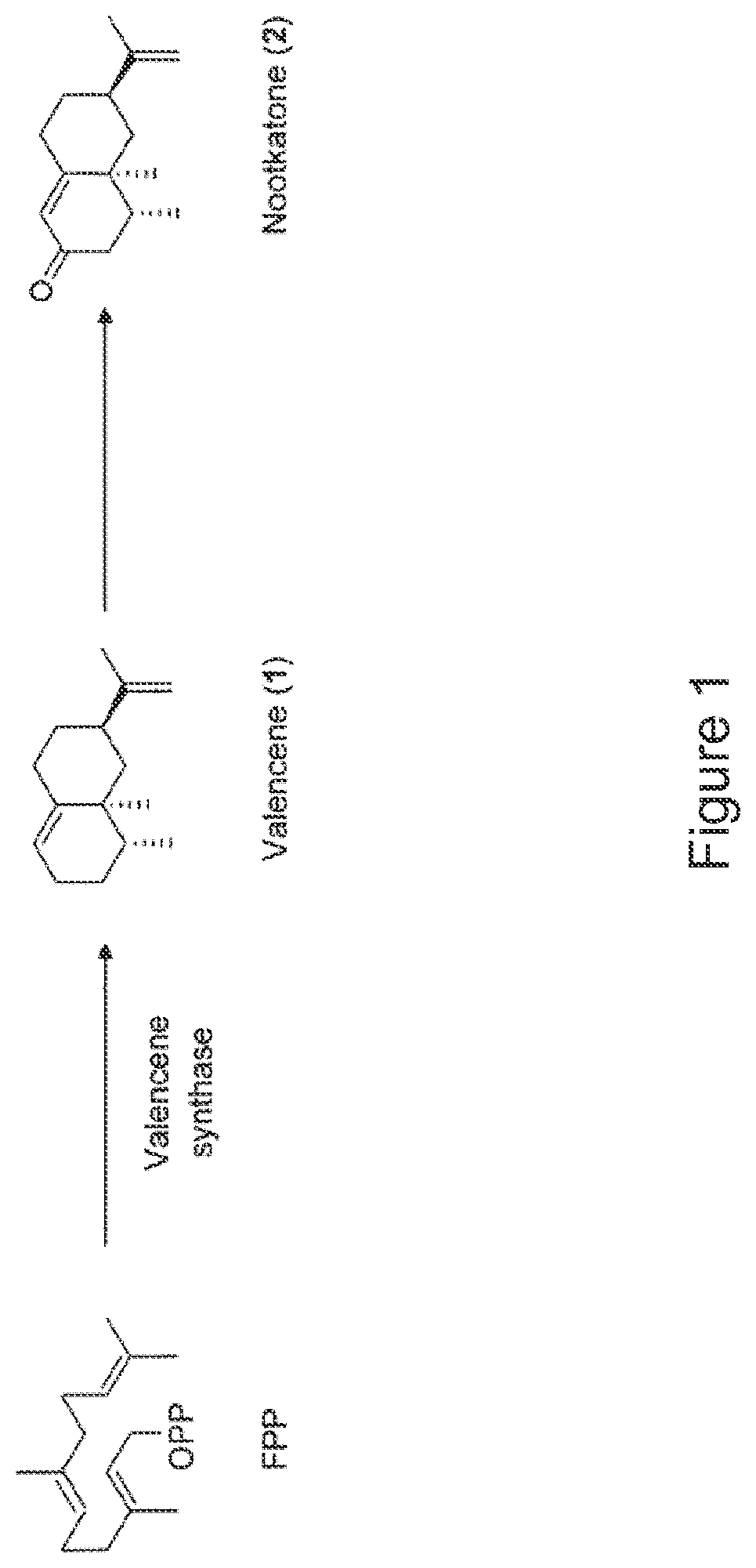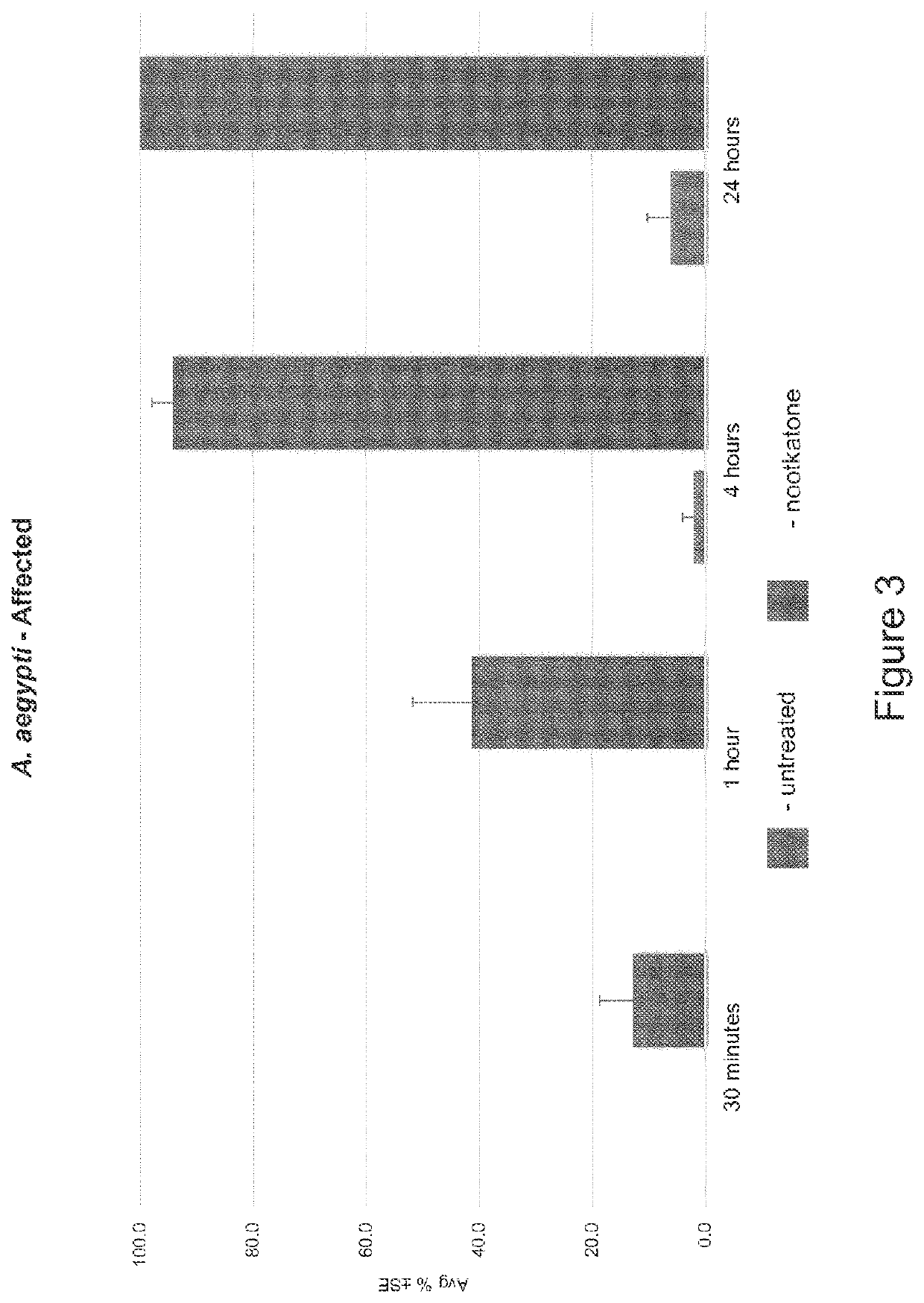Methods and compositions for the treatment of infections and arthropod infestation
a technology for arthropods and compositions, applied in the field of methods and compositions for the treatment of infections and arthropod infestation, can solve the problems of inability to effectively prevent vaccination, many other arthropod pests are problematic for humans and domestic animals, and perception cannot be remedied, so as to reduce the transmission
- Summary
- Abstract
- Description
- Claims
- Application Information
AI Technical Summary
Benefits of technology
Problems solved by technology
Method used
Image
Examples
examples
[0074]The Examples that follow are illustrative of specific embodiments of the invention, and various uses thereof. They are set forth for explanatory purposes only, and are not to be taken as limiting the invention.
Example No. 1. Nootkatone Repels Aedes aegypti Mosquitoes
[0075]In the following example, the effectiveness of 1% nootkatone compositions in repelling mosquitoes was determined in comparison with DEET in a choice design test.
Methods
[0076]Compositions of 1% nootkatone were formulated in either ethanol or acetone and coated onto collagen membrane-covered wells filled with warm blood.
[0077]Two hundred and fifty female mosquitoes aged 4-8 days were sucrose deprived for 18 hr and then introduced to the collagen membrane-covered wells. Mosquito probing of the treated collagen membranes was recorded every 2 min during a 20 min period.
[0078]Five replicates were performed. A 20% DEET composition was used as a positive control and an ethanol only solution served as a negative contr...
example no.4
Example No. 4. Nootkatone Kills a Broad Spectrum of Arthropods
Overview
[0108]In the following example, the effectiveness of a 1% nootkatone composition in killing Ae. aegypti and other mosquitoes as well as other insects was determined.
[0109]A laboratory trial was conducted to assess the efficacy of nootkatone applied to filter paper against aphids (Schizaphis gramium), dust mites (Dermatophagoides sp.), termites (Reticulitermes flavipes), deer ticks (Ixodes scapularis), biting midges (Culicoides sp.), fire ants (Solenopsis invicta), and mosquitoes (Aedes aegypti and Culex), in terms of knockdown (KD) and mortality. One concentration (1% in ethanol) of nootkatone was assessed for most species, but three concentrations (0.25%, 0.5%, and 1% in ethanol) were assessed for mosquitoes. A negative control group, consisting of filter paper treated with ethanol, was also assessed for comparison purposes for each species.
[0110]Test systems were introduced to treated filter paper, allowed to dr...
example no.5
Example No. 5: Comparison of Fermentation-Derived Nootkatone with Citrus-Derived Nootkatone
Overview
[0135]Nootkatone, as defined herein, has a particular chemical profile indicative of its constituent chemical species. Other sources of nootkatone can have different chemical profiles and therefore actually represent different chemical compositions. GC-FID analyses of the nootkatone used in the studies described above (obtained from oxidation of fermentation-derived valencene, also known as, nootkatone ex valencene (N×V)) and a citrus fruit-derived nootkatone (also known as nootkatone ex citrus, which is derived from citrus fruit and available from Frutarom®, Corona, Calif.) are shown in FIG. 6. The nootkatone used in the studies described herein lacked valencene and demonstrated a lower amount of 11,12-epoxide than the Frutarom® nootkatone. Moreover, further analysis of an unknown peak from the Frutarom® nootkatone sample revealed that the Frutarom® sample contained limonene (see FIG....
PUM
 Login to View More
Login to View More Abstract
Description
Claims
Application Information
 Login to View More
Login to View More - R&D
- Intellectual Property
- Life Sciences
- Materials
- Tech Scout
- Unparalleled Data Quality
- Higher Quality Content
- 60% Fewer Hallucinations
Browse by: Latest US Patents, China's latest patents, Technical Efficacy Thesaurus, Application Domain, Technology Topic, Popular Technical Reports.
© 2025 PatSnap. All rights reserved.Legal|Privacy policy|Modern Slavery Act Transparency Statement|Sitemap|About US| Contact US: help@patsnap.com



